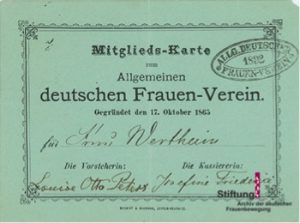General German Women’s Association (Allgemeiner Deutscher Frauenverein, ADF) (1865-2018)
“The task of the General German Women’s Association is to work, with united strength, for the higher education of the female ex and for the liberation of female work from all the obstacles that stand in the way of its full development.” – Statues of the General German Women’s Association, 1865
The General German Association Women’s Associationis the oldest German women’s right organization, founded on 18 October 1865 in Leipzig jointly initiated by Louise Otto-Peters (1819–1895), Auguste Schmidt (1833-1902), Henriette Goldschmidt (1825-1920) and Ottilie von Steyber (1804-1870).
On March 7, 1865, Auguste Schmidt gave her first public lecture, entitled “Life is striving.” In this speech, Schmidt advocated for the establishment of an educational association for women, following the model of the existing Workers Education Associations. Following this speech, Schmidt called together the headmistress Ottilie von Steyber, the writer and journalist, Louise Otto-Peters, and the educator Henriette Goldschmidtto form the General German Women’s Association or ADF. On 18 October 1865 they welcomed 300 women from Saxony in Leipzig for the founding meeting. Louise Otto-Peters was elected the first ADF president.
The General German Association Women’s Association marked the beginning of organized feminism in Germany. During a time when most women’s associations were philanthropic and their boards were made up mainly of men, the ADF chose to prohibit men from joining. This conscious choice to exclude men from the ADF faced heavy criticism from the public and fellow (male-dominated) associations but Otto-Peters and their co-leaders insisted on this emancipatory principle of female self-help and initiative within the organization. The ADF aimed to foster women’s education and to prepare them for employment; goals that challenged the traditional view of women within the nineteenth century. However, the ADF did not agitate for the political rights for women. To do so would have caused forcible dissolution by the police, as this was illegal at the time. Otto and her associates, instead, focused on working on projects they believed were more attainable in their time, such as educational rights for women, or a reform of the family and marriage laws that discriminated women. ADF’s leaders hoped that through the cultivation of general education for women, they would become more self-sufficient, independent, and as result, more worthy citizens. The journal of the new association, entitled Neue Bahnen(New Paths), was co-edited by Louise Otto-Peters and Auguste Schmidt.First published in 1865, the paper allowed groups of progressive women within Germany to communicate with each other and spread the ideas of the rising middle and upper-class women’s movement.
The ADF remained relevant within Germany society for decades. In the 1890s it witnessed a strong growth in membership and became in 1894 one of the main associations that worked for the founding of the umbrella organization of the German middle and upper-class women’s movement, the Federation of German Women’s Associations (Bund Deutscher Frauenvereine, BDF). The ADF continued to exist in the Weimar Republic but dissolved itself after January 1933, when the Nazi Party came into power, to avoid its dissolution.
After 1945 the ADF was re-founded in West Germany and works until today for equal rights for women in the economy, society and politics. Today, the ADF is called the German Association of Female Citizensand affiliates itself with the International Alliance of Women, whom, according to their programmatic statement, aims at “working to promote women’s human rights around the world, focusing particularly on empowerment of women and development issues and more broadly on gender equality.”
Rosa Bestmann, Communication Studies, Class of 2018.
Sources
Literature and Websites
- “First Feminist Efforts: Statutes of the General German Women’s Association (1865).” GHDI Documents, at http://ghdi.ghi-dc.org/sub_document.cfm?document_id=450 (Accessed April 20, 2018).
- “German Association of Female Citizens.” Wikipedia, at: https://en.wikipedia.org/wiki/German_Association_of_Female_Citizens (Accessed April 22, 2018).
- “German Association of Female Citizens.” WikiVisually, at:https://wikivisually.com/wiki/German_Association_of_Female_Citizens (Accessed April 20, 2018).
- “Our Work.” International Alliance of Women. At: http://womenalliance.org/ (Accessed April 21, 2018).
- Allgemeinen Deutschen Frauen-Verein, ed. Politisches Handbuch für Frauen. Leipzig: B.G. Teubner, 1909.
- Skylar, Katherine Kish. Social Justice Feminists in the United States and Germany: A Dialogue in Documents, 1885-1933. Ithaca, NY and London: Cornell University Press, 1998.



